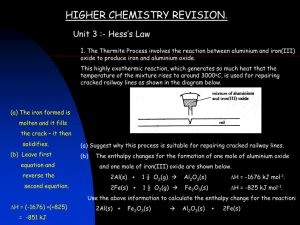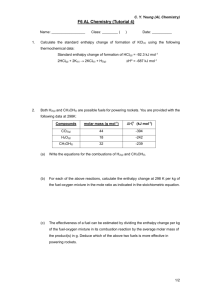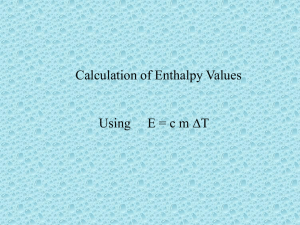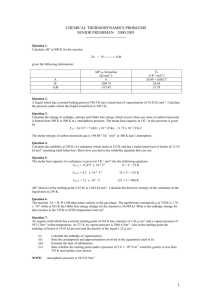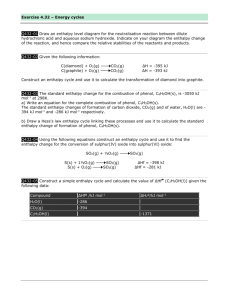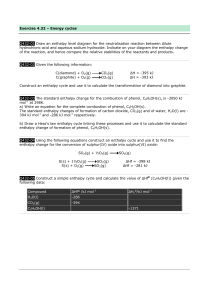higher chemistry revision. - Deans Community High School
advertisement
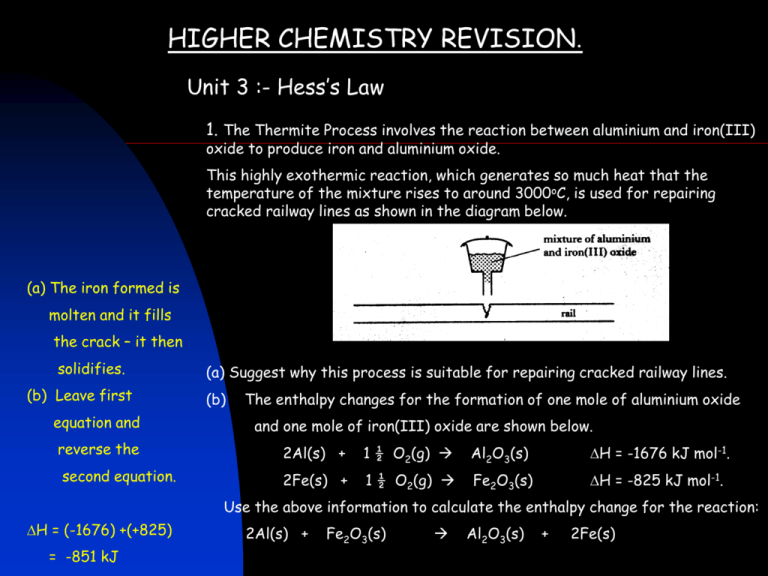
HIGHER CHEMISTRY REVISION. Unit 3 :- Hess’s Law 1. The Thermite Process involves the reaction between aluminium and iron(III) oxide to produce iron and aluminium oxide. This highly exothermic reaction, which generates so much heat that the temperature of the mixture rises to around 3000oC, is used for repairing cracked railway lines as shown in the diagram below. (a) The iron formed is molten and it fills the crack – it then solidifies. (b) Leave first equation and (a) Suggest why this process is suitable for repairing cracked railway lines. (b) The enthalpy changes for the formation of one mole of aluminium oxide and one mole of iron(III) oxide are shown below. reverse the 2Al(s) + Al2O3(s) DH = -1676 kJ mol-1. second equation. 1 ½ O2(g) 2Fe(s) + 1 ½ O2(g) Fe2O3(s) DH = -825 kJ mol-1. Use the above information to calculate the enthalpy change for the reaction: DH = (-1676) +(+825) = -851 kJ 2Al(s) + Fe2O3(s) Al2O3(s) + 2Fe(s) 2. The enthalpy of combustion of hydrogen sulphide is -563 kJ mol-1. Use this value and the enthalpy of combustion values in the data booklet to calculate the enthalpy change for the reaction: H2(g) + S(s) H2S(g) (rhombic) H2 + ½ O 2 H 2O DH1 = -286 kJ S + O2 SO2 DH2 = -297 kJ H 2S + 1 ½ O2 H2O + SO2 DH3 = -563 kJ To form the equation shown we need DH1 + DH2 - DH3 And so DH = (-286) + (-297) + (+563) = -20 kJ 3. A calorimeter, like the one shown, can be used to measure the enthalpy of combustion of ethanol. The ethanol is ignited and burns completely in the oxygen gas. The heat energy released in the reaction is taken in by the water as the hot product gases are drawn through the coiled copper pipe by the pump. (a) Why is the copper pipe coiled as shown in the diagram. (b) The value of enthalpy of combustion of ethanol obtained by the calorimeter method is higher than the value obtained by the typical school laboratory method. One reason for this is that more heat is lost to the surroundings in the typical school laboratory method. Give one other reason for the value being higher with the calorimeter method. (c) In one experiment the burning of 0.980 g of ethanol resulted in the temperature of 400 cm3 of water rising from 14.2oC to 31.6oC. Use this information to calculate the enthalpy of combustion of ethanol. (a) Coiling the pipe increases its surface area and ensures as much heat is transferred into the water as possible. (b) Using oxygen ensures complete combustion of ethanol. (c) DH=-cmDT = - 4.18 x 0.4 x 17.4 0.98 g of ethanol -29.1 kJ So 1 mol, 46g, of ethanol -1365.9 kJ = - 29.1 kJ 4. Potassium hydroxide can be used in experiments to verify Hess’s Law. The reactions concerned can be summarised as follows. +HCl(aq) KOH(s) +H2O(l) KCl(aq) DH1 DH2 DH3 KOH(aq) (a) State Hess’s Law. (b) Complete the list of measurements that would have to be made in order to calculate DH2. (i) Mass of potassium hydroxide (ii) (iii) (iv) (c) What solution must be added to the potassium hydroxide solution in order to calculate DH3? (a) The enthalpy of a reaction is independent of the reaction pathway. (b) Mass of water, initial water temperature, final water temperature. (c) Hydrochloric acid. 5. The equation for the enthalpy of formation of propanone is: 3C(s) + 3H2(g) + ½ O2 (g) C3H6O(l) Use the following information on enthalpies of combustion to calculate the enthalpy of formation of propanone. (1) (2) (3) C(s) + O2(g) CO2 (g) H2 (s) + ½ O2 (g) H2O(l) C3H6O(l) + 4O2 (g) 3CO2 (g) + 3H2O(l) DH1 = –394 kJ mol-1. DH2 = –286 kJ mol -1. DH3 = –1804 kJ mol -1. To form the equation we want we need:3 x Eqn(1) + 3 x Eqn (2) + Reverse Eqn(3) DH = (3 x –394) + (3 x –286) + (+1804) = -236 kJ 6. Some rockets have a propellant system which combines dinitrogen tetroxide with methylhydrazine. 5N2O4 + 4CH3NHNH2 xN2 + yH22O + zCO2 (a) State the values of x, y and z required to balance the above equation. (b) Draw the full structural formula for methylhydrazine. (c) Methylhydrazine burns according to the following equation. CH3NHNH2 + 2 ½ O2 CO2 + 3H2O + N2 DH = –1305 kJ mol-1. Use this information, together with information from page 9 of the data booklet, to calculate the enthalpy change for the following reaction. C + N2 + 3H2 CH3NHNH2 (a) X = 9, y = 12 and z = 4 (b) H H H H-C-N –N-H H (c) (1) CH3NHNH2 + 2.5O2 CO2 + 3H2O + N2 DH1 = –1305 kJ mol-1. (2) C + O2 CO2 DH2 = –394 kJ mol-1. (3) H2 + ½ O2 H2O DH3 = –286 kJ mol-1. To form the equation we want we need Reverse (1) + (2) + 3 x (3) DH = (1305) + (-394) + (3 x –286) = 53 kJ 7. Vinegar is a dilute solution of ethanoic acid. (a) Hess’s Law can be used to calculate the enthalpy change for the formation of ethanoic acid from its elements. 2C(s) + 2H2(g) + O2 (g) CH3COOH(l) (graphite) Calculate the enthalpy change for the above reaction, in kJ mol-1, using information from the data booklet and the following data. (1) C + O2 CO2 DH1 = –394 kJ mol-1. (2) H 2 + ½ O 2 H 2O DH2 = –286 kJ mol-1. (3) CH3COOH + 2O2 2 CO2 + 2 H2O DH3 = –876 kJ mol-1. To form the equation for the formation of ethanoic acid we need 2 x (1) + 2 x (2) + reverse (3) DH = (-788) + (-572) + (+876) = -484 kJ
